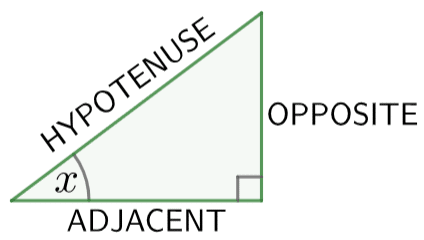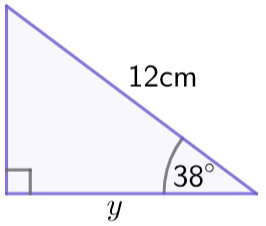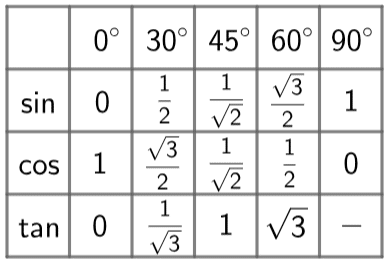This page contains the GCSE AQA Mathematics Trigonometry Questions and their answers for revision and understanding Trigonometry.
Trigonometry is the study of triangles. In this topic, we’re going to focus on three trigonometric functions that specifically concern right-angled triangles. They are: sine, cosine, and tangent, which get shortened to sin, cos, and tan.
To define what these 3 functions, we first have to understand how to label the sides of right-angled triangle. Firstly, the hypotenuse is always the longest side; it is the one opposite the right-angle.
The other two sides depend on where the angle you’re working with is. The names are quite explanatory: the opposite side is the side that is opposite to the angle, and the adjacent side is the side that is adjacent (next to) the angle. Now we know these definitions, we define the 3 functions to be:


If we let O be the opposite, A be the adjacent, and H be the hypotenuse, then these are shortened to

As a result, the acronym: SOHCAHTOA is helpful for remember which sides go with which function.
These are 3 extremely useful functions because they give us a way of relating the angles in a right-angled triangle to the side-lengths. We will be seeing how they can be used to find both missing angles and side-lengths. Quickly check your calculator to make sure you know where they are.
Example: Find the length of the side marked y to 1dp.
To work out which of sin, cos, or tan we need to use, we need to work out what sides of the triangle we are concerned with.
First of all, the side we are given to be 12cm long is the longest side – the hypotenuse (H). Secondly, the side we’re looking for is adjacent to the angle (A). So, if A and H are the two sides we care about, then it’s the ‘CAH’ part of ‘SOHCAHTOA’ that we want. In other words, we will use cos.


How do we now use this to find y? Well, it’s important to understand that cos(38) is just a number – it’s a complicated number, but our calculator will handle that. The key point is that to find y, we just need to rearrange the equation above. So, if we multiply both sides by 12, we get
y=12×cos(38)
At this point, we can just put 12×cos(38)” into the calculator and round:
y=9.4561…=9.5 cm (1dp)
This process of finding a missing side-length is the same for sin, cos, or tan. The only possible difference may be a two-step rearranging rather than just one (see: the questions below).
Next, we will see how to find a missing angle.
Example: Find the size of angle z to 2sf.
As before, we need to work out which of sin, cos, or tan we will use. This time, we are given two sides: one that opposite the angle, and another that is adjacent to the angle. So, if we have O and A, then ‘TOA’ is the part of the ‘SOHCAHTOA’ acronym that we want. In other words, we will use tan.
So, we have: O=5, A=8O=5,A=8, and our angle is z. Therefore,


Now, like before we want to rearrange the equation to find our unknown value, z. However, unlike before, z is currently trapped inside a tan, so how do we get rid of the tan? Well, on your calculator, above the ‘tan’ button, it should say tan−1 – this is usually accessed by pressing SHIFT followed by the tan button. This is the inverse tan function and it cancels out tan. What this means is that if we apply tan−1” to both sides of the equation above, it will cancel out the tan. So, we will get
 Then, we just need to type this into our calculator, remembering to press “SHIFT tan” rather than just tan. So, we get
Then, we just need to type this into our calculator, remembering to press “SHIFT tan” rather than just tan. So, we get
z=32.0053…=32° (2sf)
This works the same way with sin and cos; you will require sin−1 and cos−1 respectively.
Up to this point, we’ve let our calculators do the heavy lifting when it comes to evaluating the 3 trig functions, but there are some values of the trig functions that you have to remember. Specifically, you will have to remember sin, cos, and tan of 0°,30°,45°,60°, and 90°. The values are outlined in the table on the right.
There are a lot of values here, but also a lot of repeats. A good tip for sin and cos is: if you have two angles that add up to 90, e.g. 60 and 30, then the sin of one will be the same as the cos of another.

